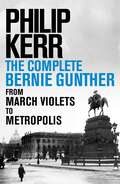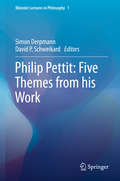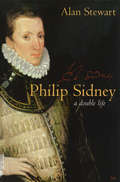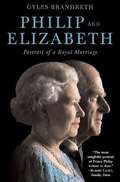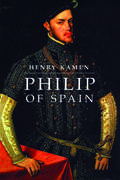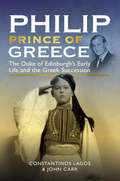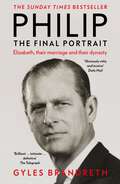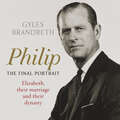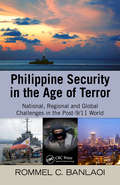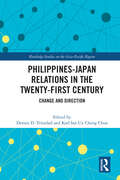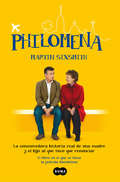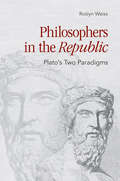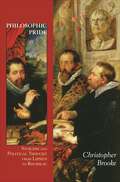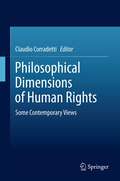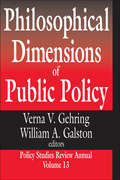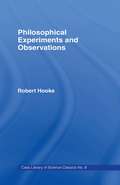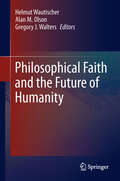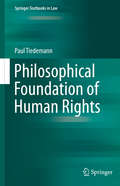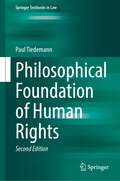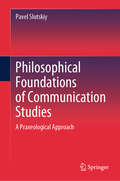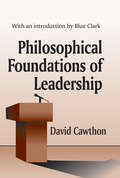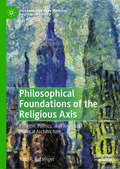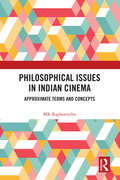- Table View
- List View
Philip Kerr: The Complete Bernie Gunther Novels (14 titles)
by Philip Kerr'One of the greatest anti-heroes ever written' LEE CHILD Snap up all 14 novels in the bestselling Bernie Gunther Series in one great-value volume.Ex-policeman Bernie Gunther thought he'd seen everything on the streets of 1930s Berlin. But then the Nazis came to power, and Bernie realised the most dangerous criminals were the ones in charge. Follow the tough, sharp-witted detective as he investigates serial killings, political assassination, blackmail and war crimes in Germany and beyond. *********************** PRAISE FOR PHILIP KERR 'Kerr's Bernie Gunther novels are modern classics' SIMON SEBAG MONTEFIORE'Kerr leads us through the facts of history and the vagaries of human nature' TOM HANKS 'One of the greatest master story-tellers in English' ALAN FURST 'One of the most memorable and original characters' THE SUNDAY TIMES 'Bitterly, darkly funny' SUNDAY HERALD
Philip Mironov and the Russian Civil War
by Sergei StarikovHe was an authentic hero of World War I and the Russian Revolution. He commanded a successful Red Army that treated prisoners mercifully, refrained from pillaging the countryside, and educated the people about the objectives of the Bolshevik regime. His eloquent advocacy of the ideas and aspirations of farmers and workers in the civil war period after World War I helped to weaken the cause of the White armies. Yet Philip Mironov has been systematically defamed in official Soviet history, and today his name is remembered by very few. This Cossack leader was distrusted and even despised by the more radical Communists, removed from his army command, and tried for treason. Leon Trotsky declared him a traitor and careerist who wanted "to climb upward on the backs of the toiling masses." After being pardoned and "rehabilitated" (at least partly through Lenin's personal intervention), Mironov continued in his independent ways until he was again arrested by the Cheka (Secret Police). While exercising in a prison courtyard in Moscow on April 2, 1921, he was mysteriously shot in the back and killed. Drawing upon archives, reminiscences, and Mironov's own brief, fragmentary, unpublished memoir, Sergi Starikov and the celebrated Soviet scholar Roy Medvedev have written a compelling book that helps explain the complex social processes of revolutionary Russia.
Philip Pettit: Five Themes from his Work
by Simon Derpmann David P. SchweikardThis volume documents the 16th Münster Lectures in Philosophy and examines five themes that are prominent in the work of philosopher and political theorist Philip Pettit. These themes are: Epistemology and Semantics, Philosophy of Mind, Consequentialism, Group Agency, and Republicanism. The book provides insight into Pettit's work and demonstrates the central role his work plays in a number of contemporary philosophical debates. Pettit's contributions to the philosophy of mind and action, rational choice theory, the philosophy of the social sciences, as well as metaethics, normative ethics and political philosophy are main points of reference, and have advanced ongoing and initiated new discussions. The book shows that a striking feature of Pettit's work has been the depth of his analyses and arguments regarding individual topics - ranging from rule-following to free will, from group agency to social ontology and the methodology of the social sciences, from a defense of consequentialism to the revival of the republican tradition in the theory of democracy and to value theory, but also their systematic overall coherence. The book contains Pettit's lecture "Freedom and Other Robustly Demanding Goods", nine critical papers on Pettit's philosophy, and a reply article entitled "Self-Defense on Five Fronts: A Reply to My Commentators".
Philip Sidney: A Double Life
by Alan StewartCourtier, poet, soldier, diplomat - Philip Sidney was one of the most promising young men of his age. Son of Elizabeth I's deputy in Ireland, nephew and heir to her favourite, Leicester, he was tipped for high office - and even to inherit the throne. But Sidney soon found himself caught up in the intricate politics of Elizabeth's court and forced to become as Machiavellian as everyone around him if he was to achieve his ambitions. Against a backdrop of Elizabethan intrigue and the battle between Protestant and Catholic for predominance in Europe, Alan Stewart tells the riveting story of Philip Sidney's struggle to suceed. Seeing that his continental allies had a greater sense of his importance that his English contamporaries, Philip turned his attention to Europe. He was made a French baron at seventeen, corresponded with leading foreign scholars, considered marriage proposals from two princesses and, at the time of his tragically early death, was being openly spoken of as the next ruler of the Netherlands.
Philip and Elizabeth: Portrait of a Royal Marriage
by Gyles Daubeney BrandrethBrandeth relates the long and sometimes unhappy story of the Queen of England and the Duke of Edinburgh with a jaunty, chatty style and inside knowledge based on his acquaintance with the Duke over 25 years. The biography covers the couples' lives together and apart and focuses on their different personalities and upbringings. Brandeth also reveals details about the couples' famous relatives, including their children and in-laws. Annotation ©2006 Book News, Inc., Portland, OR (booknews.com)
Philip of Spain
by Henry KamenPhilip II of Spain-ruler of the most extensive empire the world had ever known-has been viewed in a harsh and negative light since his death in 1598. Identified with repression, bigotry, and fanaticism by his enemies, he has been judged more by the political events of his reign than by his person. This book, published four hundred years after Philip's death, is the first full-scale biography of the king. Placing him within the social, cultural, religious, and regional context of his times, it presents a startling new picture of his character and reign.Drawing on Philip's unpublished correspondence and on many other archival sources, Henry Kamen reveals much about Philip the youth, the man, the husband, the father, the frequently troubled Christian, and the king. Kamen finds that Philip was a cosmopolitan prince whose extensive experience of northern Europe broadened his cultural imagination and tastes, whose staunchly conservative ideas were far from being illiberal and fanatical, whose religious attitudes led him to accept a practical coexistence with Protestants and Jews, and whose support for Las Casas and other defenders of the Indians in America helped determine government policy. Shedding completely new light on most aspects of Philip's private life and, in consequence, on his public actions, the book is the definitive portrayal of Philip II.
Philip, Prince of Greece: The Duke of Edinburgh's Early Life and the Greek Succession
by John Carr Constantinos LagosMany books have been written about the life of Prince Philip, the Duke of Edinburgh, yet there always seem to be corners of his long life that have remained unexplored. In this long look back into his early years, Constantinos Lagos and John Carr uncover hitherto unknown aspects of Philip's life as a Greek prince and his gradual transformation from a mere appendage of the troubled Greek royal family to an enduring pillar of the British monarchy. For the first time, Lagos and Carr delve into neglected Greek archives for a fascinating picture of Philip's early Greek life and the constant insecurity that dogged his steps as his father Prince Andrew of Greece and mother Princess Alice struggled to order their own lives in the maelstrom of unstable and often violent Greek politics in a Europe sliding towards world war. The Greek royal family, in which Philip has his roots, is dealt with at length, to bring out the particular family history and circumstances that played no small part in shaping his personality. Anyone curious about how Prince Philip actually grew up will find in this book a wealth of eye-opening, often startling details that will add more brush strokes to the portrait of the often-elusive but real Prince Philip.
Philip: The Final Portrait - THE INSTANT SUNDAY TIMES BESTSELLER
by Gyles Brandreth____________________________________________________________________________________ THE SUNDAY TIMES TOP 10 BESTSELLER 'It's bloody brilliant, totally inspiring ... it's a joy to read a book that comes from a perspective of fondness. There are whole pages I want to read to the kids and stick to the fridge.' - KIRSTIE ALLSOPP, THE TIMES 'As a sparkling celebration of Prince Philip, the book will be hard to beat' - THE TELEGRAPH'Brandreth explores a temperament on the brink of anger and agitation with immense tact, even affection.' - THE SPECTATOR'This affectionate biography of Prince Philip is stuffed with entertaining anecdotes ... so readable and refreshing even after the millions of words that have been written about Prince Philip in the past couple of weeks.' - THE TIMES'Brilliant... there is so much in this book you won't find anywhere else.' - LORRAINE'A stately, respectful and joyful tribute. It is an extraordinary story, told with unique insight and authority by an author who knew him for more than 40 years.' - EDINBURGH EVENING NEWS______________________________________________________________________________________This is the story of Prince Philip, Duke of Edinburgh - the longest-serving consort to the longest-reigning sovereign in British history. It is an extraordinary story, told with unique insight and authority by an author who knew the prince for more than forty years. Philip - elusive, complex, controversial, challenging, often humorous, sometimes irascible - is the man Elizabeth II once described as her 'constant strength and guide'. Who was he? What was he really like? What is the truth about those 'gaffes' and the rumours of affairs? This is the final portrait of an unexpected and often much-misunderstood figure. It is also the portrait of a remarkable marriage that endured for more than seventy years. Philip and Elizabeth were both royal by birth, both great-great-grandchildren of Queen Victoria, but, in temperament and upbringing, they were two very different people. The Queen's childhood was loving and secure, the Duke's was turbulent; his grandfather assassinated, his father arrested, his family exiled, his parents separated when he was only ten. Elizabeth and Philip met as cousins in the 1930s. They married in 1947, aged twenty-one and twenty-six. Philip: The Final Portrait tells the story of two contrasting lives, assesses the Duke of Edinburgh's character and achievement, and explores the nature of his relationships with his wife, his children and their families - and with the press and public and those at court who were suspicious of him in the early days. This is a powerful, revealing and, ultimately, moving account of a long life and a remarkable royal partnership.
Philip: The Final Portrait - THE INSTANT SUNDAY TIMES BESTSELLER
by Gyles Brandreth______________________________________________________________________________________**THE SUNDAY TIMES TOP 10 BESTSELLER**'As a sparkling celebration of Prince Philip, the book will be hard to beat' - THE TELEGRAPH'Brandreth explores a temperament on the brink of anger and agitation with immense tact, even affection.' - THE SPECTATOR'This affectionate biography of Prince Philip is stuffed with entertaining anecdotes ...so readable and refreshing even after the millions of words that have been written about Prince Philip in the past couple of weeks.' - THE TIMES'Brilliant... there is so much in this book you won't find anywhere else.' - LORRAINE'A stately, respectful and joyful tribute. It is an extraordinary story, told with unique insight and authority by an author who knew him for more than 40 years.' -EDINBURGH EVENING NEWSThis is the story of Prince Philip, Duke of Edinburgh - the longest-serving consort to the longest-reigning sovereign in British history. It is an extraordinary story, told with unique insight and authority by an author who knew the prince for more than forty years. Philip - elusive, complex, controversial, challenging, often humorous, sometimes irascible - is the man Elizabeth II once described as her 'constant strength and guide'. Who was he? What was he really like? What is the truth about those 'gaffes' and the rumours of affairs? This is the final portrait of an unexpected and often much-misunderstood figure. It is also the portrait of a remarkable marriage that endured for more than seventy years. Philip and Elizabeth were both royal by birth, both great-great-grandchildren of Queen Victoria, but, in temperament and upbringing, they were two very different people. The Queen's childhood was loving and secure, the Duke's was turbulent; his grandfather assassinated, his father arrested, his family exiled, his parents separated when he was only ten. Elizabeth and Philip met as cousins in the 1930s. They married in 1947, aged twenty-one and twenty-six. Philip: The Final Portrait tells the story of two contrasting lives, assesses the Duke of Edinburgh's character and achievement, and explores the nature of his relationships with his wife, his children and their families - and with the press and public and those at court who were suspicious of him in the early days. This is a powerful, revealing and, ultimately, moving account of a long life and a remarkable royal partnership.
Philip: The Final Portrait - THE INSTANT SUNDAY TIMES BESTSELLER
by Gyles BrandrethElizabeth, their marriage and their dynasty.This is the story of Prince Philip, Duke of Edinburgh - the longest-serving consort to the longest-reigning sovereign in British history. It is an extraordinary story, told with unique insight and authority by an author who knew the prince for more than forty years. Philip - elusive, complex, controversial, challenging, often humorous, sometimes irascible - is the man Elizabeth II once described as her 'constant strength and guide'. Who was he? What was he really like? What is the truth about those 'gaffes' and the rumours of affairs? This is the final portrait of an unexpected and often much-misunderstood figure. It is also the portrait of a remarkable marriage that endured for more than seventy years. Philip and Elizabeth were both royal by birth, both great-great-grandchildren of Queen Victoria, but, in temperament and upbringing, they were two very different people. The Queen's childhood was loving and secure, the Duke's was turbulent; his grandfather assassinated, his father arrested, his family exiled, his parents separated when he was only ten. Elizabeth and Philip met as cousins in the 1930s. They married in 1947, aged twenty-one and twenty-six. Philip: The Final Portrait tells the story of two contrasting lives, assesses the Duke of Edinburgh's character and achievement, and explores the nature of his relationships with his wife, his children and their families - and with the press and public and those at court who were suspicious of him in the early days. This is a powerful, revealing and, ultimately, moving account of a long life and a remarkable royal partnership.(P)2021 Hodder & Stoughton Limited
Philippine Security in the Age of Terror: National, Regional, and Global Challenges in the Post-9/11 World
by Rommel BanlaoiAs the twelfth most populous nation, the Philippines diverse religious and ethnic population makes it an ideal example of the changing tenet of what is deemed national security post 9/11. Issues previously considered social or public are now viewed as security issues. Food production is now analyzed in the context of food security and environmenta
Philippines-Japan Relations in the Twenty-First Century: Change and Direction (Routledge Studies on the Asia-Pacific Region)
by Dennis D. Trinidad Karl Ian Uy Cheng ChuaTrinidad and Chua provide invaluable insights on various dimensions and directions of 21st-century Philippines-Japan relations from Filipino and Japanese scholars. Their chapters highlight the adjustments made in the relationship as the two countries grapple with old and emerging domestic issues amid changing international contexts.The book’s multidisciplinary approach and rich empirical data provide an in-depth understanding and analysis of the two countries’ diplomatic and growing security cooperation, deepening economic ties and sociocultural exchanges, rising mobility of people, and the past’s impacts on the present.This is a comprehensive volume for international scholars and researchers interested in Japanese and Philippine studies, security studies, Southeast Asian history, and political economy, as well as those interested in migration studies, comparative politics, and sociocultural studies.
Philomena
by Martin SixsmithNew York Times Bestseller. Now a major motion picture starring Judi Dench and Steve Coogan and nominated for four Academy Awards: the heartbreaking true story of an Irishwoman and the secret she kept for 50 years. When she became pregnant as a teenager in Ireland in 1952, Philomena Lee was sent to a convent to be looked after as a "fallen woman. ” Then the nuns took her baby from her and sold him, like thousands of others, to America for adoption. Fifty years later, Philomena decided to find him. Meanwhile, on the other side of the Atlantic, Philomena’s son was trying to find her. Renamed Michael Hess, he had become a leading lawyer in the first Bush administration, and he struggled to hide secrets that would jeopardize his career in the Republican Party and endanger his quest to find his mother. A gripping exposé told with novelistic intrigue, Philomena pulls back the curtain on the role of the Catholic Church in forced adoptions and on the love between a mother and son who endured a lifelong separation.
Philosophers in the Republic: Plato's Two Paradigms
by Roslyn WeissIn Plato's Republic, Socrates contends that philosophers make the best rulers because only they behold with their mind's eye the eternal and purely intelligible Forms of the Just, the Noble, and the Good. When, in addition, these men and women are endowed with a vast array of moral, intellectual, and personal virtues and are appropriately educated, surely no one could doubt the wisdom of entrusting to them the governance of cities. Although it is widely-and reasonably-assumed that all the Republic's philosophers are the same, Roslyn Weiss argues in this boldly original book that the Republic actually contains two distinct and irreconcilable portrayals of the philosopher.According to Weiss, Plato's two paradigms of the philosopher are the "philosopher by nature" and the "philosopher by design." Philosophers by design, as the allegory of the Cave vividly shows, must be forcibly dragged from the material world of pleasure to the sublime realm of the intellect, and from there back down again to the "Cave" to rule the beautiful city envisioned by Socrates and his interlocutors. Yet philosophers by nature, described earlier in the Republic, are distinguished by their natural yearning to encounter the transcendent realm of pure Forms, as well as by a willingness to serve others-at least under appropriate circumstances. In contrast to both sets of philosophers stands Socrates, who represents a third paradigm, one, however, that is no more than hinted at in the Republic. As a man who not only loves "what is" but is also utterly devoted to the justice of others-even at great personal cost-Socrates surpasses both the philosophers by design and the philosophers by nature. By shedding light on an aspect of the Republic that has escaped notice, Weiss's new interpretation will challenge Plato scholars to revisit their assumptions about Plato's moral and political philosophy.
Philosophic Pride: Stoicism and Political Thought from Lipsius to Rousseau
by Christopher BrookePhilosophic Pride is the first full-scale look at the essential place of Stoicism in the foundations of modern political thought. Spanning the period from Justus Lipsius's Politics in 1589 to Jean-Jacques Rousseau's Emile in 1762, and concentrating on arguments originating from England, France, and the Netherlands, the book considers how political writers of the period engaged with the ideas of the Roman and Greek Stoics that they found in works by Cicero, Seneca, Epictetus, and Marcus Aurelius. Christopher Brooke examines key texts in their historical context, paying special attention to the history of classical scholarship and the historiography of philosophy.Brooke delves into the persisting tension between Stoicism and the tradition of Augustinian anti-Stoic criticism, which held Stoicism to be a philosophy for the proud who denied their fallen condition. Concentrating on arguments in moral psychology surrounding the foundations of human sociability and self-love, Philosophic Pride details how the engagement with Roman Stoicism shaped early modern political philosophy and offers significant new interpretations of Lipsius and Rousseau together with fresh perspectives on the political thought of Hugo Grotius and Thomas Hobbes.Philosophic Pride shows how the legacy of the Stoics played a vital role in European intellectual life in the early modern era.
Philosophical Dimensions of Human Rights
by Claudio CorradettiThis book presents a unique collection of the most relevant perspectives in contemporary human rights philosophy. Different intellectual traditions are brought together to explore some of the core postmodern issues challenging standard justifications. Widely accessible also to non experts, contributions aim at opening new perspectives on the state of the art of the philosophy of human rights. This makes this book particularly suitable to human rights experts as well as master and doctoral students. Further, while conceived in a uniform and homogeneous way, the book is internally organized around three central themes: an introduction to theories of rights and their relation to values; a set of contributions presenting some of the most influential contemporary strategies; and finally a number of articles evaluating those empirical challenges springing from the implementation of human rights. This specific set-up of the book provides readers with a stimulating presentation of a growing and interconnecting number of problems that post-natural law theories face today. While most of the contributions are new and specifically conceived for the present occasion, the volume includes also some recently published influential essays on rights, democracy and their political implementation.
Philosophical Dimensions of Public Policy
by William A. Galston Verna V. GehringAt the mid-point of the twentieth century, many philosophers in the English-speaking world regarded political and moral philosophy as all but moribund. Thinkers influenced by logical positivism believe that ethical statements are merely disguised expressions of individual emotion lacking propositional force, or that the conditions for the validation of ethical statements could not be specified, or that their content, however humanly meaningful, is inexpressible.Philosophical Dimensions of Public Policy presents thirty-four articles written by research scholars numerous fields-philosophy, political theory, medicine, law, biology, economics, ecology and sociology-treating a broad range of topics in practical philosophy. The Institute for Philosophy and Public Affairs has been home for these ideas, pioneering a distinctive method of conducting inquiry into the moral dimensions of public life, and contributing to public discussion and deliberation. Members of the Institute reject the idea that public philosophy means reaching into the philosopher's tool-kit and "applying" prefabricated theories to particular problems. They set in motion a dialogue between the distinctive moral features of practical problems and the more general moral theories or considerations that seem most likely to elucidate these problems.The volume is divided into five areas: "Politics, Civic Life, and Moral Education"; "Diversity, Identity, and Equal Opportunity"; "Human Rights, Development Ethics, and International Justice"; "Biotechnology, Genetic Research, and Health Policy"; and "Natural Environment, Human Communities."Philosophical Dimensions of Public Policy presents empirical data and philosophical arguments with the intention of informing public policy and public deliberation. Scholars as well as graduate and undergraduate students are certain to find it useful to their research work.
Philosophical Experiments and Observations
by Robert Hooke W. DerhamShortly after Hooke died in 1703, his miscellaneous papers and unpublished manuscripts were entrusted to Richard Waller, who edited and published some of them in a volume titled The Posthumous Works of Robert Hooke (1705; reprinted, Frank Cass, 1968). Waller himself died, however, before he was able to complete the task of republishing Hooke’s papers and they were eventually handed on to William Derham. After delaying for what some of Hooke’s followers thought to be a scandalously long time, Derham finally published this volume in 1726. It contains numerous papers and notes by Hooke as well as a number of important papers and letters written by Hooke’s contemporaries and found, evidently, among Hooke’s literary remains. This is an exact facsimile reproduction of Derham’s edition of the Philosophical experiments and Observations of the late Eminent Dr. Rober Hooke (1726) except that an analytical table of contents, prepared by the General Editor, has been added. First Published in 1967. Routledge is an imprint of Taylor & Francis, an informa company.
Philosophical Faith and the Future of Humanity
by Helmut Wautischer Alan M. Olson Gregory J. WaltersKarl Jaspers, who died in 1969, had a profound impact on 20th-century theology and philosophy. His central thesis called for, among other things, a de-centering of philosophy from its Eurocentric roots and a renewal of its dialogue with other traditions, especially Asian ones. This collection of essays includes unpublished work by Jaspers himself as well as testimonies to his life and career by colleagues, associates, and translators, some of who knew Jaspers personally. Readers will also find commentary and interpretation by researchers who have explored Jaspers' work for decades, and a biographical account of Jaspers' student Leonard Ehrlich, who handled much of Jaspers' English translation. The book interrogates Jaspers' conceptions of 'philosophical faith', his philosophy of communication, and the prospects for world philosophy in the future. Focusing on philosophical faith, it assesses Jaspers' interpretations of key philosophers such as Kant, Hegel, Schelling, Kierkegaard, Nietzsche, and Rosenzweig, as well as examining his personal relationships with Bultmann and Heidegger. Contributors also look at Jaspers' philosophies of religion and history, his hypothesis of the 'axial age' (Achsenzeit), and his contributions to metaphysics, periechontology, and economics. Finally, chapters cover Jaspers' philosophy of communication and world history. The latter are informed by a burgeoning interest in Kantian 'Freiheitphilosophie' that influenced Jaspers, as well as concerns over the future of humanity. These concerns in part account for Jaspers' growing popularity in the Middle East, Eastern Europe, Central/South America, and Asia. Also included are lucid clarifications of the difference between religious and philosophical faith, and the relevance of certainty, trust, and communication for a future of mankind. Trained as a psychiatrist, Jaspers practiced this profession before becoming a philosopher and thus had a keen insight into the workings of the human mind even as he challenged the philosophical establishment of his time. It is perhaps this depth to his background that adds to the contemporary relevance of his work.
Philosophical Foundation of Human Rights (Springer Textbooks in Law)
by Paul TiedemannThis textbook presents a range of classical philosophical approaches in order to show that they are unsuitable as a foundation for human rights. Only the conception of human dignity –based on the Kantian distinction between price and dignity – can provide a sufficient basis. The derivation of human rights from the principle of human dignity allows us to identify the most crucial characteristic of human rights, namely the protection of personhood. This in turn makes it possible (1) to distinguish between real moral human rights and spurious ones, (2) to assess the scope of protection for many codified human rights according to the criteria of “core” and “yard,” and (3) offers a point of departure for creating new, unwritten human rights. This philosophical basis supports a substantial reassessment of the case law on human rights, which will ultimately allow us to improve it with regard to legal certainty, clarity and cogency.The textbook is primarily intended for advanced law students who are interested in a deeper understanding of human rights. It is also suitable for humanities students, and for anyone in the political or social arena whose work involves human rights and their enforcement.Each chapter is divided into four parts: Abstracts, Lecture, Recommended Reading, and Questions to check reader comprehension. Sample answers are included at the end of the book.
Philosophical Foundation of Human Rights (Springer Textbooks in Law)
by Paul TiedemannThis textbook presents a range of classical philosophical approaches in order to show that they are unsuitable as a foundation for human rights. Only the conception of human dignity –based on the Kantian distinction between price and dignity – can provide a sufficient basis. The derivation of human rights from the principle of human dignity allows us to identify the most crucial characteristic of human rights, namely the protection of personhood. This in turn makes it possible (1) to distinguish between real moral human rights and spurious ones, (2) to assess the scope of protection for many codified human rights according to the criteria of “core” and “yard,” and (3) offers a point of departure for creating new, unwritten human rights. This philosophical basis supports a substantial reassessment of the case law on human rights, which will ultimately allow us to improve it with regard to legal certainty, clarity and cogency.In the second edition, errors have been corrected in numerous places, the text has been made clearer and easier to understand. In addition, more recent human rights issues have been newly included, especially those related to the Corona epidemic and climate change. The textbook is primarily intended for advanced law students who are interested in a deeper understanding of human rights. It is also suitable for humanities students, and for anyone in the political or social arena whose work involves human rights and their enforcement.Each chapter is divided into four parts: Abstracts, Lecture, Recommended Reading, and Questions to check reader comprehension. Sample answers are included at the end of the book.
Philosophical Foundations of Communication Studies: A Praxeological Approach
by Pavel SlutskiyThis book explores the philosophical foundations of communication studies, suggesting that communication phenomena extend beyond the scope of traditional scientific methods. It argues that communication, deeply intertwined with human behavior, cannot be fully comprehended through empirical methods alone. The book presents an epistemological alternative to empiricism in communication studies—an alternative rooted in the praxeological perspective. Drawing from the principles of rationalism, it proposes that conclusions about communication can be deduced from a priori theoretical truths, rather than empirical evidence. This book is a crucial resource for scholars in both philosophy and communication studies.
Philosophical Foundations of Leadership
by David CawthornThe nature of leadership and the human qualities that promote or inhibit it have a long history in Western thought and remain a central concern in modern societies. Crises in leadership may arise from either human failings or social complexities that defeat or reject those most qualified to lead. While most contemporary political or social commentators on such crises tend to focus on external circumstances, David Cawthon examines classical thinkers from Plato to Nietzsche to offer a historical and philosophical perspective on the intrinsic qualities of leadership and how these qualities are coded into the souls of some, but not of others.
Philosophical Foundations of the Religious Axis: Religion, Politics, and American Political Architecture (Palgrave Studies in Religion, Politics, and Policy)
by John R. PottengerThis book discusses the evolution of three philosophical foundations from the twelfth through the eighteenth centuries that converged to form the basis of liberal democracy’s approach to the place and role of religion in society and politics. Identified by the author as a “religious axis,” the period of convergence promoted rational and empirical investigation, enabled the development of diverse religious beliefs, and affirmed religious liberty and expressions amidst pluralist politics. The author shows that the religious axis’ three philosophical foundations—epistemic, axiological, and political—undergird the political architecture of American liberal democracy that designed a containment structure to protect a vast array of religious expressions and encourage their presence in the public square. Moreover, the structure embodied a democratic ethos that drives religious and political pluralism—but within limits. The author argues that this containment structure has paradoxically ignited frenzied fires of faith that politically threaten the structure’s own limits.
Philosophical Issues in Indian Cinema: Approximate Terms and Concepts
by MK RaghavendraThis book interrogates the vocabulary used in theorizing about Indian cinema to reach into the deeper cultural meanings of philosophies and traditions from which it derives its influences. It re-examines terms and concepts used in film criticism and contextualizes them within the aesthetics, poetics and politics of Indian cinema. The book looks at terms and concepts borrowed from the scholarship on American and world cinema and explores their use and relevance in describing the characteristics and evolution of cinema in India. It highlights how realism, romance and melodrama in the context of India appear in a culturally singular way and how the aggregation of constituent elements – like songs, action, comedy – in Indian film can be traced to classical theatre and other diverse religious and philosophical influences. These influences have characterized popular film and drama in India which present all aspects of life for a diverse nation. The author explores concepts like ‘fantasy’, ‘family’ and ‘patriotism’ by using various examples from films in India and outside, as well as practices in the other arts. He identifies the fundamental logic behind the choices made by film-makers in India and discusses concepts which allow for a fresh theorizing on Indian cinema’s characteristics. This book will be of great interest to students and researchers of film studies, media studies, cultural studies, literature, cultural history and South Asian studies. It will also be useful for general readers who are interested in learning more about Indian cinema, its forms, origins and influences.
